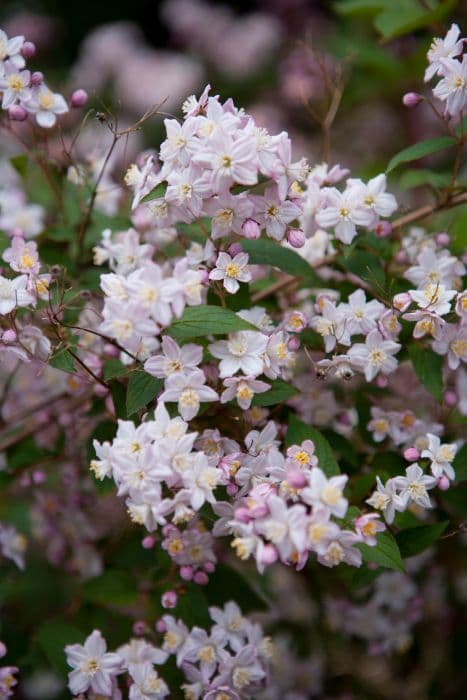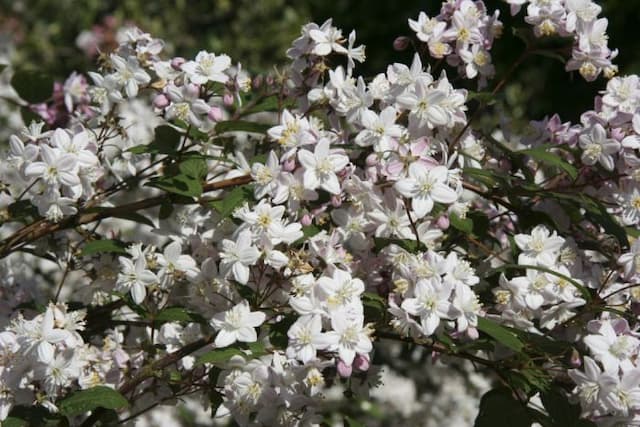Pinky Winky Hydrangea Hydrangea paniculata Pinky-winky = 'Dvppinky' (PBR)
![paniculate hydrangea [Pinky-Winky]](/_next/image?url=https%3A%2F%2Fplants-admin.emdemapps.com%2Fimages%2Fplants%2F%2Fimages%2F604b53575acd3.png&w=3840&q=75)
ABOUT
Pinky Winky Hydrangea is a striking ornamental plant known for its distinctive flowers. The plant produces large conical panicles that bloom from mid to late summer. These flower clusters start out a soft white and gradually transform to a vibrant pink, beginning at the base and progressing to the tip, giving it a two-toned appearance. The flowers are held atop strong stems that manage their weight without drooping. The foliage of Pinky Winky Hydrangea is a lush green that provides a beautiful contrast to the changing colors of the blooms. The leaves are broad, oval-shaped, and have a coarse texture. The plant itself forms a dense bush with a rounded growing habit, making it an attractive addition to gardens not only for its flowers but also for its overall shape and structure. Furthermore, the blossoms of Pinky Winky Hydrangea are known to persist through the season, often drying on the plant and adding interest even as the garden transitions into fall.
About this plant
 Names
NamesFamily
Hydrangeaceae
Synonyms
Pinky Winky Hydrangea, Panicled Hydrangea, Panicle Hydrangea
Common names
Hydrangea paniculata Pinky-winky = 'Dvppinky' (PBR).
 Toxicity
ToxicityTo humans
Hydrangea, generally, can be toxic to humans if ingested. The plant contains compounds such as hydrangin which is a cyanogenic glycoside. This can lead to the release of cyanide in the body when the plant material is ingested in large quantities. Symptoms of poisoning can include nausea, vomiting, stomach pain, diarrhea, and sweating. In severe cases, dizziness, headache, and confusion may occur due to the cyanide's effect of inhibiting the body's ability to use oxygen. However, accidental poisoning from hydrangeas in humans is rare, as quite a substantial amount of plant material would need to be consumed to cause a severe reaction.
To pets
Hydrangea is also toxic to pets, including dogs and cats, if ingested. The same compounds that affect humans, such as cyanogenic glycosides, can cause similar symptoms in pets. These can include vomiting, diarrhea, lethargy, and in severe cases, more intense manifestations like depression or confusion due to cyanide toxicity. Pets that consume any part of the hydrangea plant should be monitored closely, and veterinary attention may be necessary, especially if a significant amount has been ingested.
 Characteristics
CharacteristicsLife cycle
Perennials
Foliage type
Deciduous
Color of leaves
Green
Flower color
Pink
Height
6-8 feet (1.8-2.4 meters)
Spread
4-6 feet (1.2-1.8 meters)
Plant type
Shrub
Hardiness zones
3-8
Native area
China and Japan
Benefits
 General Benefits
General Benefits- Ornamental Appeal: Produces large, showy flowers that start white and mature to pink, creating a two-toned effect.
- Extended Blooming Period: Blooms from early summer to fall, providing long-lasting visual interest.
- Drought Tolerance: Once established, it can tolerate periods of dry weather, reducing the need for frequent watering.
- Cold Hardiness: Capable of withstanding low temperatures, making it suitable for gardens in cooler climates.
- Wildlife Attraction: Flowers provide nectar for pollinators such as bees and butterflies, supporting biodiversity.
- Easy to Prune: Responds well to pruning, which can be used to control the plant's size or to encourage more prolific blooming.
- Versatility in Landscaping: Can be used as a statement plant in gardens, as hedge or border, or in large containers for patio display.
- Low Maintenance: Requires minimal care once established, apart from occasional pruning and watering in prolonged droughts.
- Adaptable: Can thrive in a variety of soil types, although it prefers well-drained soils with consistent moisture.
 Medical Properties
Medical PropertiesThis plant is not used for medical purposes.
 Air-purifying Qualities
Air-purifying QualitiesThis plant is not specifically known for air purifying qualities.
 Other Uses
Other Uses- Photography Prop: The large, colorful cones of flowers make the Hydrangea paniculata Pinky Winky ideal for use as a backdrop or feature in garden photography.
- Wedding Decorations: Its flowers can be dried and used in wedding bouquets or as part of table centerpieces for a rustic or vintage-themed wedding.
- Craft Projects: The dried flower heads can be used in a variety of craft projects, from wreath making to potpourri.
- Educational Tool: Teachers can use it to instruct students on pollination, as its flowers are attractive to pollinators like bees and butterflies.
- Fabric Dyeing: The flowers can be used to create natural dyes for fabrics, yielding soft, pastel colors.
- Baking Garnish: While not edible, the blooms can be used as a temporary, decorative garnish on cakes or desserts for events (they should be removed before consumption).
- Plant Structure Study: The sturdy stems and distinct flower development of Pinky Winky can be used to study plant structure and growth in a scientific or educational setting.
- Artistic Inspiration: The plant's striking appearance can serve as a muse for artists, providing a subject for painting, drawing, or photography.
- Garden Theme Visuals: Used in theme gardens that display a gradient of colors, Pinky Winky can contribute to a visual transition due to its pink and white flowers.
- Seasonal Celebrations: Because they bloom from mid-summer to fall, the flowers can be used for decorating during seasonal festivals or celebrations to enhance the ambiance with their color.
Interesting Facts
 Feng Shui
Feng ShuiHydrangea is not used in Feng Shui practice.
 Zodiac Sign Compitability
Zodiac Sign CompitabilityHydrangea is not used in astrology practice.
 Plant Symbolism
Plant Symbolism- Heartfelt Emotions: The lavish blooms of the Pinky Winky Hydrangea symbolize the abundance of feelings that can be conveyed from one person to another, embodying deep understanding and empathy.
- Gratitude: Giving a Pinky Winky Hydrangea as a gift is often seen as a gesture of thanks, representing appreciation and acknowledgement of someone’s kindness or help.
- Abundance and Prosperity: With its lush and full flower heads, the Pinky Winky Hydrangea can signify abundance and prosperity, making it an ideal gift for housewarmings or celebrations of success.
- Fourth Wedding Anniversary: Hydrangeas, including the Pinky Winky variety, are traditional gifts for fourth wedding anniversaries, symbolizing appreciation and enduring love between spouses.
 Water
WaterThe Pinky Winky Hydrangea should be watered deeply once a week, ensuring moisture reaches the root zone. During periods of drought or extreme heat, increase the frequency to twice a week. The method involves pouring water at the base of the plant rather than overhead sprinkling to avoid wetting the foliage which could lead to fungal diseases. Each watering session should provide the hydrangea with about 1 gallon of water or enough to moisten the soil to a depth of at least 6 inches.
 Light
LightThe Pinky Winky Hydrangea thrives best in full sun to part shade conditions. The ideal location is one where the plant can receive at least 4 hours of direct sunlight daily, preferably morning light with some afternoon shade to protect from the intense heat of the day.
 Temperature
TemperatureThe Pinky Winky Hydrangea can tolerate a wide range of temperatures and is hardy in USDA zones 3 through 8. It can survive minimum temperatures down to -40 degrees Fahrenheit and prefers a growing environment with temperatures ranging between 65 to 75 degrees Fahrenheit.
 Pruning
PruningPrune the Pinky Winky Hydrangea in late winter or early spring before new growth starts to remove dead wood and to shape the plant. It blooms on new wood, so pruning will not affect the blooms. Annually removing about a third of the oldest stems will encourage vigorous growth and larger flower heads.
 Cleaning
CleaningAs needed
 Soil
SoilThe best soil mix for the Pinky Winky Hydrangea is one that is rich in organic matter, well-draining, and has a pH level of around 6.0 to 7.0. You can create a suitable mix with garden soil, peat moss, and compost in equal parts. Mulching is beneficial to maintain moisture and soil temperature.
 Repotting
RepottingPinky Winky Hydrangeas do not typically require frequent repotting as they are usually grown in the ground. If grown in containers, repotting every 2-3 years or when rootbound is sufficient. Ensure the new container is only slightly larger than the previous one.
 Humidity & Misting
Humidity & MistingPinky Winky Hydrangeas thrive in average outdoor humidity levels but do not require specific humidity adjustments if grown indoors. They are adaptable to different humidity levels found in typical garden environments.
 Suitable locations
Suitable locationsIndoor
Provide bright light and keep moist for indoor Pinky Winkies.
Outdoor
Plant in sun to part shade and mulch well for outdoor growth.
Hardiness zone
3-8 USDA
 Life cycle
Life cycleHydrangea paniculata 'Pinky Winky' starts its life as a seed, which with suitable conditions of moisture and temperature, germinates into a seedling. The seedling then develops into a juvenile plant, establishing a root system and foliage through vegetative growth. Over time, it matures and enters the flowering stage, where it produces characteristic white flowers that mature to a pink color, hence the name 'Pinky Winky'. After pollination, the flowers produce seeds, completing the reproductive cycle. The plant then enters a period of dormancy during the colder months, shedding leaves if grown in a climate with a notable winter. In spring, the plant breaks dormancy, beginning a new growth cycle with fresh foliage and preparing for the next flowering period.
 Propogation
PropogationPropogation time
Spring-Early Summer
The Hydrangea paniculata Pinky Winky, commonly known as Pinky Winky Hydrangea, is most popularly propagated through softwood cuttings. This method typically takes place in late spring or early summer when the new growth is still soft and pliable. To propagate, a 4 to 6-inch cutting from a healthy branch is taken, making sure the cutting includes several pairs of leaves. The lower leaves are removed, and the cut end is dipped in rooting hormone to aid in root development. Then, the cutting is placed in a pot with moist, well-draining potting mix and covered with a plastic bag to create a greenhouse effect. The cutting should be kept out of direct sunlight and remain consistently moist. Roots generally develop within 4 to 6 weeks, after which time the new Pinky Winky Hydrangea plant can gradually be acclimated to outdoor conditions and eventually planted in the garden.








![Hydrangea [Early Sensation]](/_next/image?url=https%3A%2F%2Fplants-admin.emdemapps.com%2Fimages%2Fplants%2F%2Fimages%2F604b6150338db.png&w=640&q=75)
